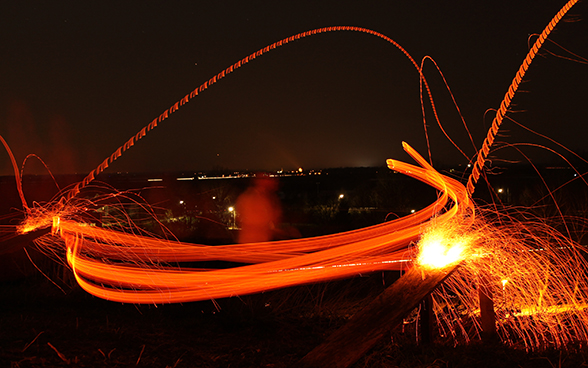The same traditions and customs are often celebrated under different names from one place to the next, and “Scheibenschlagen” (disc beating) is one such custom. When searching for information on the origins and significance of disc beating, the many different terms used to describe it are a challenge. Researching the names in dialect and the various spellings requires a great deal of linguistic imagination and tenacity.
Disc beating has been on Switzerland’s list of living traditions since 2012. The custom is usually celebrated on the first Saturday or Sunday of Lent in several valleys in Graubünden and parts of Baselland. The Federal Office of Culture has compiled documentation on disc beating and published it online together with a list of further reading. The website living-traditions.ch is a good place to start to get an initial introduction to the custom.
Pitfalls in the search for information
Those who want to research the origins and evolving significance of disc beating in more depth can consult the library catalogues, specialised bibliographies, such as the Bibliography of Swiss History, but also the portals of digitised periodicals (e-periodica.ch) and newspapers (e-npa.ch). But we soon encounter a difficulty that is typical with this type of research: disc beating (“Scheibenschlagen” in High German) is referred to in different regions variously as “Schiibaschlaha”, “Schyblischiesse”, “Schybeschiesse”, “Schybefleuge”, “Füürreedlispränge”, “Reedlischigge”, “Reedlischwinge”. On top of the array of names, there are also variations in the spelling of names in local dialect. The library catalogues and the portals featuring digitised full texts, such as e-npa.ch and e-periodica, treat the search terms entered exactly in line with current practices. This offers the advantage that the number of hits is also “more accurate“ than a less precise treatment that includes similar search terms, where the user needs to sift out the relevant information in the search results. However, for the researcher, this means that all synonyms and spelling variations of “Scheibenschlagen” must be appropriately entered in the search field – which requires a great deal of linguistic imagination and tenacity.
The custom’s origin and significance
Anthropologically speaking, these practices are likely to stem from people’s experience of cold and darkness during the winter months and the longing for sunlight and warmth, where the gloom is symbolically vanquished, and winter is ‘driven away’ with fire and sometimes with noise, or the sun is magically ‘brought back’. Jakob Kuratli, a teacher from the Swiss town of Azmoos, who carried out an ethnological study on disc beating in the Sarganserland in the 1950s, concluded that the custom was an ancient fire cult. The custom was therefore of celtic origin, he argued, yet there is no written evidence or archaeological proof to support this.
What is historically documented, however, is the Christian appropriation of older pagan festivals and the associated customs and rituals. A prominent example is Christmas, which the Church celebrates after the winter solstice, in other words at the same time as the ancient festival in honour of the invincible Sun, Sol Invictus.
In a Christian interpretation, the glowing wooden discs that are catapulted into the air during the “Scheibenschlagen” ritual, are seen as wheels of fortune or fate. The disc flying through the air is understood as a symbol of human life and destiny, which also has its ups and downs (as Gottfried von Strassburg writes in “Tristan”).
A new social function
Whether carnival custom, a way of driving out winter, or a symbol of life – the origins of disc beating are uncertain, and the meanings attributed to it are many and varied. The social function of this custom has also changed with the times. In the village of Untervaz in Graubünden, disc beating had been in danger of dying out since the 1960s. The traditional organising bodies had fallen out of favour with the younger members of the community and new arrivals, which meant that the know-how and expertise needed to make the discs, bake the traditional “Chüechli” cakes, and stitch the white gowns was at risk of being lost. Thanks to initiatives by individuals and the local authority, disc beating is now popular again and has evolved to become a village festival that plays an important social role in bringing together young and old, locals and new arrivals.
Bibliography and sources
- Scheibenschlagen (disc beating). In: Living traditions in Switzerland.
- Hans Peter Berger, Scheibenschlagen in Graubünden. In: Bündner Jahrbuch N.F. 34 (1992), p. 126-133.
- Hermann Hiltbruner, Scheibenschlagen ["Redlischloo"] / Leimentaler Fastnacht, 1946. [manuscript in the Swiss Literary Archives].
- Jakob Kuratli: Das Scheibenschlagen einst und jetzt. In: Sarganserland. Beitrage zu seiner Geschichte und Kultur, 3 (1955), No. 1 / 2 (January / February), p. 1-11.
- Philipp Ryser: Winteraustreiben oder ein Sinnbild für das Leben? Reedlischigge in Biel-Benken. In: Akzent. Magazin für Kultur und Gesellschaft 2010, Volume 1 (February): Schwerpunkt Feuerbräuche, p. 14-18.
- Ueli Gyr, Bräuche (customs). In: Historical Dictionary of Switzerland.
Last modification 07.02.2024
Contact
Swiss National Library
SwissInfoDesk
Information Retrieval Service
Hallwylstrasse 15
3003
Bern
Switzerland
Phone
+41 58 462 89 35






